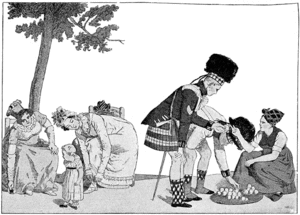History of the kilt facts for kids
The history of the modern kilt goes back to at least the late 1500s. The kilt first appeared as the belted plaid, also called the great kilt. This was a long piece of clothing. Its top part could be worn like a cloak over the shoulder, or pulled over the head like a hood. The small kilt or walking kilt is more like the kilts we see today. It started to be used in the late 1600s or early 1700s. It's basically the bottom half of the great kilt.
The word kilt comes from the Scots word kilt. This means 'to tuck up clothes around the body'. The Scots word comes from an old Norse word, kjalta, which means 'lap' or 'fold of a gathered skirt'.
Contents
The Great Kilt: An Ancient Garment

The belted plaid (called breacan an fhéilidh in Gaelic) is also known as the great kilt. It probably grew out of an older woollen cloak called a "brat" in the 1500s. This cloak was worn over a tunic. The older cloak might have been plain or had different patterns, like tartan. This depended on how wealthy the person was.
As more wool became available in the 1500s, the cloak got bigger. People started gathering it up and holding it with a belt. The belted plaid was a long piece of thick woollen cloth. It was made from two pieces sewn together, making it about 54 to 60 inches (140 to 150 cm) wide and up to 7 yards (6.4 m) long. This long cloth was folded into pleats and held tight with a wide belt.
By the 1700s, some plaids even had belt loops sewn inside. This meant they could be unpleated into a blanket or quickly pleated with a hidden drawstring belt. Another belt was worn on the outside to keep the pleats flat.
The top part of the great kilt could be worn in different ways. It could be draped over the left shoulder like a cloak. It could hang down over the belt and be gathered at the front. Or, it could be pulled over the shoulders or head to protect against bad weather. People wore it over a léine, which was a long-sleeved tunic. The great kilt could also be used as a blanket when camping.
A description from 1746 said:
The garb is certainly very loose, and fits men inured to it to go through great fatigues, to make very quick marches, to bear out against the inclemency of the weather, to wade through rivers, and shelter in huts, woods, and rocks upon occasion; which men dressed in the low country garb could not possibly endure.

For battles, it was common to take off the plaid first and set it aside. Soldiers would then make a Highland charge wearing only a léine croich. This was a war shirt, usually knee-length and made of leather, linen, or canvas. It was often heavily pleated and sometimes padded for protection.
The exact age of the great kilt is still discussed. Some old pictures before the 1500s might show the léine instead of a kilt. The first clear written description of the belted plaid or great kilt is from 1594. The great kilt is mostly linked to the Scottish Highlands. However, it was also used in poor rural areas of the Scottish Lowlands. This type of kilt was widely used until the 1800s. Some people still wear it today for very formal attire events.
The Small Kilt: A Modern Style
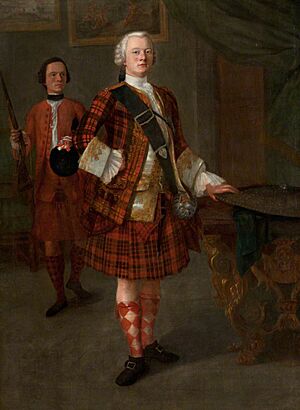
Around the late 1600s or early 1700s, the small kilt (fèileadh beag, also called filibeg or philabeg) became popular. This kilt used a single piece of cloth that hung down below the belt. It became common throughout the Highlands and northern Lowlands by 1746. But the great kilt was still worn too. The small kilt is a newer version of the great kilt, basically its bottom half.
The modern, tailored kilt was adopted by the Highland regiments of the British Army. This military kilt, with its special accessories, then became popular for everyday wear in the early 1800s. It has stayed popular ever since.
The oldest existing example of a tailored kilt is from about 1796. A military kilt from the Gordon Highlanders (92nd Regiment of Foot) from about 1817 is still in great condition today.
Who Invented the Small Kilt?
There's a story about how the small kilt was invented. A letter from 1768 said that a man named Thomas Rawlinson invented it in the 1720s. He was a Quaker from England. After a rebellion in 1715, the government allowed people to use the Highlands for business. Rawlinson worked with Ian MacDonnell, a clan chief, to make charcoal and iron.
The story says that the belted plaid worn by the Highlanders was too big and clumsy for their work. So, Rawlinson and a tailor created a kilt that was just the lower half of the belted plaid. It had pleats already sewn in. Rawlinson wore it himself, and so did his business partner. Then, the clan members started wearing it too.
Many people have debated this story. Some say it's a "myth" and that Highlanders might have worn shorter versions of the plaid before Rawlinson. Others believe Rawlinson helped make the small kilt popular. What we do know is that Rawlinson's factory is the earliest place where a kilt with sewn-in pleats was clearly documented. Sewn-in pleats are a key feature of the kilt worn today.
The Kilt: Banned and Brought Back
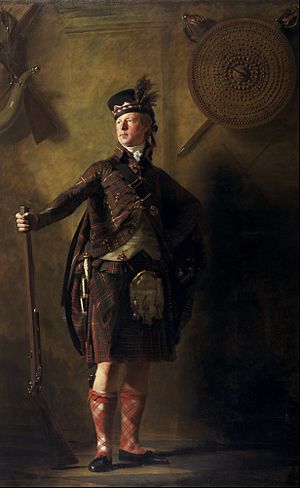
In the past, Highland clans were very loyal to their clan chief and the monarch. The Jacobite risings (rebellions) showed the government that these warrior clans could be a danger. So, in 1746, King George II's government passed the "Dress Act". This law made it illegal for men and boys to wear Highland dress, including kilts. The goal was to stop Highland culture.
There was one exception: the Highland regiments in the army could still wear kilts. The punishments for breaking the law were harsh: six months in prison for the first time, and seven years of being sent away for the second time. The ban lasted for 35 years.
Because of the ban, the kilt was not used much in the Scottish Highlands, except by the Army. But during these years, it became popular for Scottish romantics to wear kilts. This was a way to protest the ban. Many people in the Lowlands, who had once feared Highlanders, now felt a connection to them. The kilt became a symbol of a romantic past.
When the ban was lifted in 1782, Highland landowners created Highland Societies. These groups wanted to bring back "the ancient Highland dress." The Celtic Society of Edinburgh, led by Walter Scott, encouraged people from the Lowlands to join in this interest.
The kilt became a symbol for all of Scotland when King George IV visited in 1822. Even though most Scots lived in the Lowlands, Scott and the Highland societies organized a big event. They created new Scottish traditions, including Lowlanders wearing a styled version of the kilt. At this time, many other traditions, like linking specific tartans to specific clans, were also developed. Before this, tartans were more linked to regions.
After that, the kilt became an even stronger symbol of Scottish culture. King George IV wore a grand kilt, and his successor, Queen Victoria, dressed her sons in kilts. This made the kilt even more popular. The kilt became a key part of Scottish national identity.
Kilts in the Military
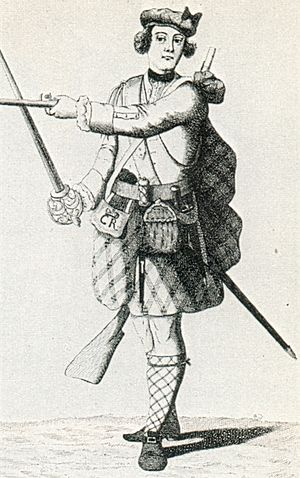
From 1624, the Independent Highland Companies wore kilts as government soldiers. When they joined to form the 42nd Regiment of Foot in 1739, their small-kilt uniform was standardized. They got a new dark tartan, known today as "Black Watch."
Many Jacobite rebels wore kilts as an informal uniform. Even their English supporters wore tartan during the Jacobite rising of 1745. After that rebellion, the government decided to create more Highland regiments for the army. This was a way to use the energy of the Gaels, who were seen as "hardy and intrepid." By doing this, they formed strong new army regiments to fight in places like India and North America. This also helped prevent rebellions at home.
Army uniforms were allowed to wear kilts, even with the Dress Act ban. To tell regiments apart, they were given different tartans. These regiments chose the modern kilts for their everyday uniforms. While the great kilt was still used for formal uniforms, it was slowly removed by the early 1800s.
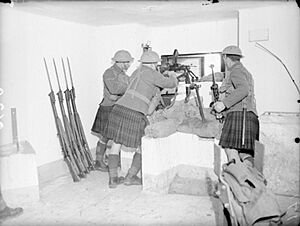
Many Scottish units wore the kilt in battles during the First World War. There's a common story that Germans called them 'Devils in Skirts' or 'Ladies from Hell'. However, there's not much proof that Germans actually used these names. It's more likely that the Scottish soldiers themselves made up these nicknames.
Highland regiments in the Commonwealth armies started the Second World War wearing the kilt. But it was quickly seen as not practical for modern fighting. In the first year of the war, it was officially banned as combat dress. Still, some individuals continued to wear it. It's thought the kilt was last widely worn in action during the evacuation of Dunkirk in May 1940. However, on D-Day in June 1944, Lord Lovat had his personal piper, Bill Millin, with him. Millin wore a kilt and played the bagpipes while bullets flew around him.
Today, the kilt is part of the modern full-dress uniforms for several active Scottish regiments in the British Army. These include the Royal Regiment of Scotland, Scots Guards, and Royal Scots Dragoon Guards.
Images for kids


